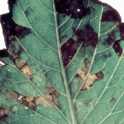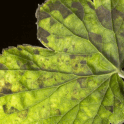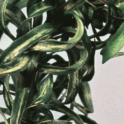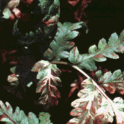Foliar Nematodes
Foliar nematodes: Worms under your plant's skin
by J. Ole Becker, Antoon T. Ploeg and Jennifer Smith Becker
Plant parasitic nematodes are small roundworms that cause tremendous economic damage in agriculture and horticulture. As their bodies are typically microscopic in size and transparent, they are difficult to detect and to identify. Most of these plant pathogens occur in soil or in subterranean plant parts. They feed on living plant tissues, influence the plant's physiology and may cause below and above ground symptoms such as root galling, lesions, stunting, wilting or chlorosis. Most of these symptoms are non-specific and can be attributed to a number of abiotic and biotic problems.
Foliar nematodes, also named bud and leaf nematodes, occur mainly within the leaves and crowns of many herbaceous perennials. Typical symptoms include localized chlorotic or purplish angular lesions that are delineated by leaf veins. The infestation usually starts at the base of the lower leaves, where humidity is highest, and spreads upward. The lesion eventually turns blackish-brown and affected parts may shrivel. If buds or young leaves are infested, they may not develop properly and may become deformed. Flower development may also be affected.
In dahlia, the necrotic lesions often disintegrate (Figure 1). Lesions on African violets appear as sunken areas between veins on the lower leaf surface that eventually extend through the tissues to the upper epidermis. Under moist conditions, the number of leaf spots or the size of the affected area will increase; eventually the leaves will desiccate but usually will remain on the plant. It is thought that the recent increase in foliar nematode-damage occurrence may be attributed to an increase in vegetative propagation and to marketing venues such as supermarkets that lack the expertise of specialized nurseries.
Two species of foliar nematodes (Aphelenchoides ritzemabosi and A. fragariae) are mainly responsible for the described disease on ornamentals. Nematodes in the genus Aphelenchoides occur commonly throughout the world. Aphelenchoides ritzemabosi and A. fragariae prefer cool, moist conditions and are therefore more of a problem in temperate regions. In California, they occur primarily in coastal regions and in glasshouse production systems, in particular during winter and early spring. They have been reported on more than 250 plant species in nearly 50 families that include both herbaceous and woody plants. Examples of common hosts include abelia, African violet, ageratum, anemone (Figure 2), aster, astilbe, bergenia, begonia, calceolaria, chrysanthemum, coral bells, cyclamen, dahlia, delphinium, fig, foxglove, geranium, goldenrod, groundsel, hellebore, hosta, hydrangea, iris, leopard’s bane, lily (Figure 3), marigolds, narcissus, peony, peperomia, phlox, pincushion flower, primrose, ranunculus, rhododendron, rudbeckia, saxifrage, snapdragon, sneezeweed, speedwell, statice, stonecrop, verbena, wallflower and zinnia. Numerous ferns are also susceptible to A. fragariae (Figure 4).
Adult foliar nematodes are about 0.04 inches (1 millimeter) long. Sexual reproduction is required for fertile offspring, but fertilized females can store sperm in a specialized organ to allow continued reproduction for months without additional fertilization. The females deposit 25 to 30 eggs in a compact group, and within 3 to 4 days, after the first molt inside the egg, the second stage juveniles hatch. Leaf nematode problems are usually restricted to high-humidity environments because the nematodes need a thin water-film to be present on the plant surface in order to move. The nematodes penetrate the leaf through the stomata, the pore openings in the leaf surface through which gas and water vapor exchange occurs, and move between the mesophyll cells. They feed by inserting their hypodermic syringe-like mouth stylet into cells to withdraw the contents, causing the cells to die and discolor. Large veins limit the migration within the leaf resulting in the frequently observed angular leaf spots. The nematodes mature through a series of molts to become adults. Reproduction is prolific, and they complete their life cycle under optimal conditions in 12 to 14 days. Numerous generations may occur, and leaf infestation can reach very high levels, with up to 64,000 nematodes having been found in a single infected leaf.
Soil-free propagation techniques and hygiene have greatly reduced the occurrence of foliar nematodes. Outbreaks are typically traced back to infested but asymptomatic vegetative propagation material such as rooted cuttings or seedlings. Field soil or poorly composted organic material should never be used in planting mixes unless it is treated appropriately to eliminate nematodes and other soilborne pathogens.
Although there are a few pesticides that may reduce nematode populations, we do not suggest or condone the use of these materials for control of nematodes in nursery production. The efficacy is typically very poor and the consumer is left with an infested plant that will eventually be the source for further nematode dissemination. In production nurseries there should be zero tolerance to foliar nematodes and any nematode occurrence needs to be thoroughly cleaned and disinfested. Diseased plants and old foliage should be destroyed. In slowly-drying leaf tissues, foliar nematodes are able to survive by undergoing major physiological changes. This state of so-called anhydrobiosis is characterized by a lack of detectable metabolic activity. However, the nematode is still alive and even after years of immobility can regain activity when allowed to rehydrate. Dried nematodes can easily be spread when working in a crop.
Consumers who discover diseased leaves on their house or garden plants should remove those as well as any plant debris. Crowding of plants, overhead watering or high humidity should be avoided to mitigate the risk of nematode dissemination via water films on plant surfaces.
J. Ole Becker and Antoon T. Ploeg are UC Cooperative Extension Specialists and Nematologists and Jennifer Smith Becker is Assistant Specialist, Department of Nematology, UC Riverside
Figures
Click on thumbnails to view entire figures.
Figure 1. Dahlia leaf with lesions caused by foliar nematodes.
Figure 2. Foliar nematode symptoms on anemone. Note angular chlorotic and necrotic patterns. Image by Steve Tjosvold
Figure 3. Lily with distorted growth and chlorotic lesions due to foliar nematodes.
Figure 4. Fern leaves with chlorotic and necrotic lesions caused by foliar nematodes.
















